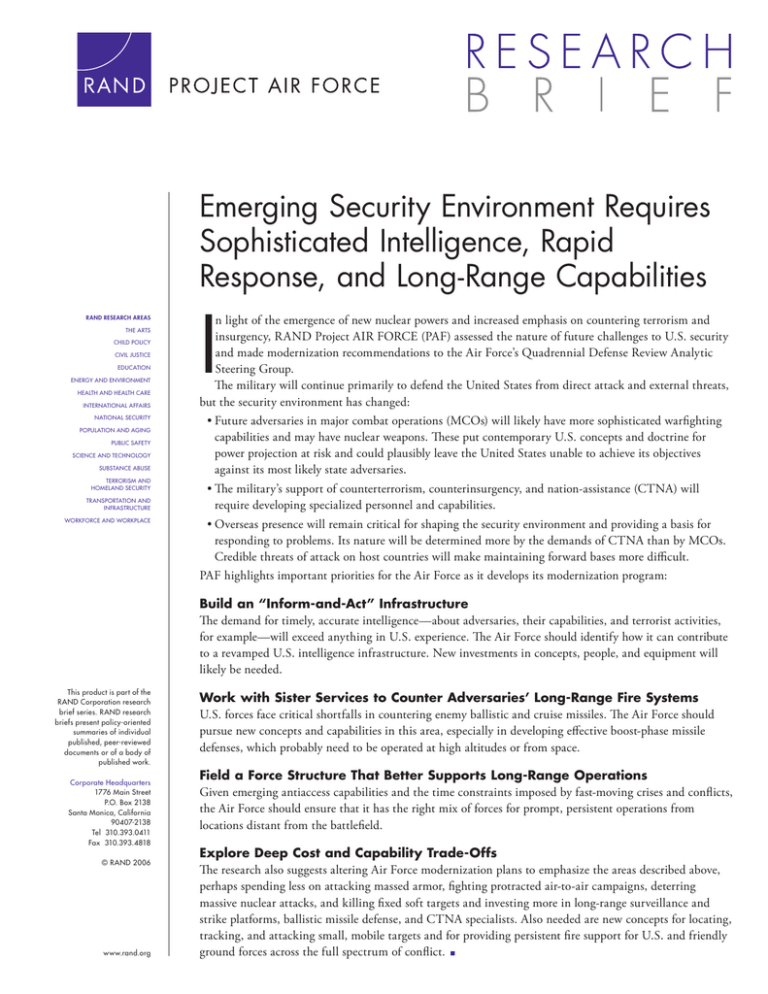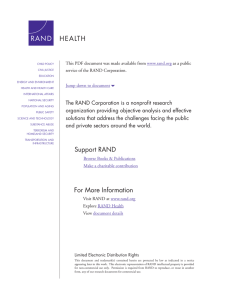Emerging Security Environment Requires Sophisticated Intelligence, Rapid Response, and Long-Range Capabilities
advertisement

Emerging Security Environment Requires Sophisticated Intelligence, Rapid Response, and Long-Range Capabilities RAND RESEARCH AREAS THE ARTS CHILD POLICY CIVIL JUSTICE EDUCATION ENERGY AND ENVIRONMENT HEALTH AND HEALTH CARE INTERNATIONAL AFFAIRS NATIONAL SECURITY POPULATION AND AGING PUBLIC SAFETY SCIENCE AND TECHNOLOGY SUBSTANCE ABUSE TERRORISM AND HOMELAND SECURITY TRANSPORTATION AND INFRASTRUCTURE WORKFORCE AND WORKPLACE I n light of the emergence of new nuclear powers and increased emphasis on countering terrorism and insurgency, RAND Project AIR FORCE (PAF) assessed the nature of future challenges to U.S. security and made modernization recommendations to the Air Force’s Quadrennial Defense Review Analytic Steering Group. The military will continue primarily to defend the United States from direct attack and external threats, but the security environment has changed: • Future adversaries in major combat operations (MCOs) will likely have more sophisticated warfighting capabilities and may have nuclear weapons. These put contemporary U.S. concepts and doctrine for power projection at risk and could plausibly leave the United States unable to achieve its objectives against its most likely state adversaries. • The military’s support of counterterrorism, counterinsurgency, and nation-assistance (CTNA) will require developing specialized personnel and capabilities. • Overseas presence will remain critical for shaping the security environment and providing a basis for responding to problems. Its nature will be determined more by the demands of CTNA than by MCOs. Credible threats of attack on host countries will make maintaining forward bases more difficult. PAF highlights important priorities for the Air Force as it develops its modernization program: Build an “Inform-and-Act” Infrastructure The demand for timely, accurate intelligence—about adversaries, their capabilities, and terrorist activities, for example—will exceed anything in U.S. experience. The Air Force should identify how it can contribute to a revamped U.S. intelligence infrastructure. New investments in concepts, people, and equipment will likely be needed. This product is part of the RAND Corporation research brief series. RAND research briefs present policy-oriented summaries of individual published, peer-reviewed documents or of a body of published work. Corporate Headquarters 1776 Main Street P.O. Box 2138 Santa Monica, California 90407-2138 Tel 310.393.0411 Fax 310.393.4818 © RAND 2006 www.rand.org Work with Sister Services to Counter Adversaries’ Long-Range Fire Systems U.S. forces face critical shortfalls in countering enemy ballistic and cruise missiles. The Air Force should pursue new concepts and capabilities in this area, especially in developing effective boost-phase missile defenses, which probably need to be operated at high altitudes or from space. Field a Force Structure That Better Supports Long-Range Operations Given emerging antiaccess capabilities and the time constraints imposed by fast-moving crises and conflicts, the Air Force should ensure that it has the right mix of forces for prompt, persistent operations from locations distant from the battlefield. Explore Deep Cost and Capability Trade-Offs The research also suggests altering Air Force modernization plans to emphasize the areas described above, perhaps spending less on attacking massed armor, fighting protracted air-to-air campaigns, deterring massive nuclear attacks, and killing fi xed soft targets and investing more in long-range surveillance and strike platforms, ballistic missile defense, and CTNA specialists. Also needed are new concepts for locating, tracking, and attacking small, mobile targets and for providing persistent fire support for U.S. and friendly ground forces across the full spectrum of conflict. This research brief describes work done for RAND Project AIR FORCE and documented in Shaping the Future Air Force, by David A. Shlapak, TR-322-AF (available at http://www. rand.org/pubs/technical_reports/TR322/), 2006, 40 pp., ISBN: 0-8330-3879-6. The RAND Corporation is a nonprofit research organization providing objective analysis and effective solutions that address the challenges facing the public and private sectors around the world. RAND’s publications do not necessarily reflect the opinions of its research clients and sponsors. R® is a registered trademark. RAND Offices Santa Monica, CA RB-197-AF (2006) • Washington, DC • Pittsburgh, PA • Jackson, MS • Doha, QA • Berlin, DE • Cambridge, UK • Leiden, NL THE ARTS CHILD POLICY This PDF document was made available from www.rand.org as a public service of the RAND Corporation. CIVIL JUSTICE EDUCATION ENERGY AND ENVIRONMENT HEALTH AND HEALTH CARE INTERNATIONAL AFFAIRS NATIONAL SECURITY This product is part of the RAND Corporation research brief series. RAND research briefs present policy-oriented summaries of individual published, peerreviewed documents or of a body of published work. POPULATION AND AGING PUBLIC SAFETY SCIENCE AND TECHNOLOGY SUBSTANCE ABUSE TERRORISM AND HOMELAND SECURITY TRANSPORTATION AND INFRASTRUCTURE The RAND Corporation is a nonprofit research organization providing objective analysis and effective solutions that address the challenges facing the public and private sectors around the world. WORKFORCE AND WORKPLACE Support RAND Browse Books & Publications Make a charitable contribution For More Information Visit RAND at www.rand.org Explore RAND Project AIR FORCE View document details Limited Electronic Distribution Rights This document and trademark(s) contained herein are protected by law as indicated in a notice appearing later in this work. This electronic representation of RAND intellectual property is provided for noncommercial use only. Permission is required from RAND to reproduce, or reuse in another form, any of our research documents for commercial use.





